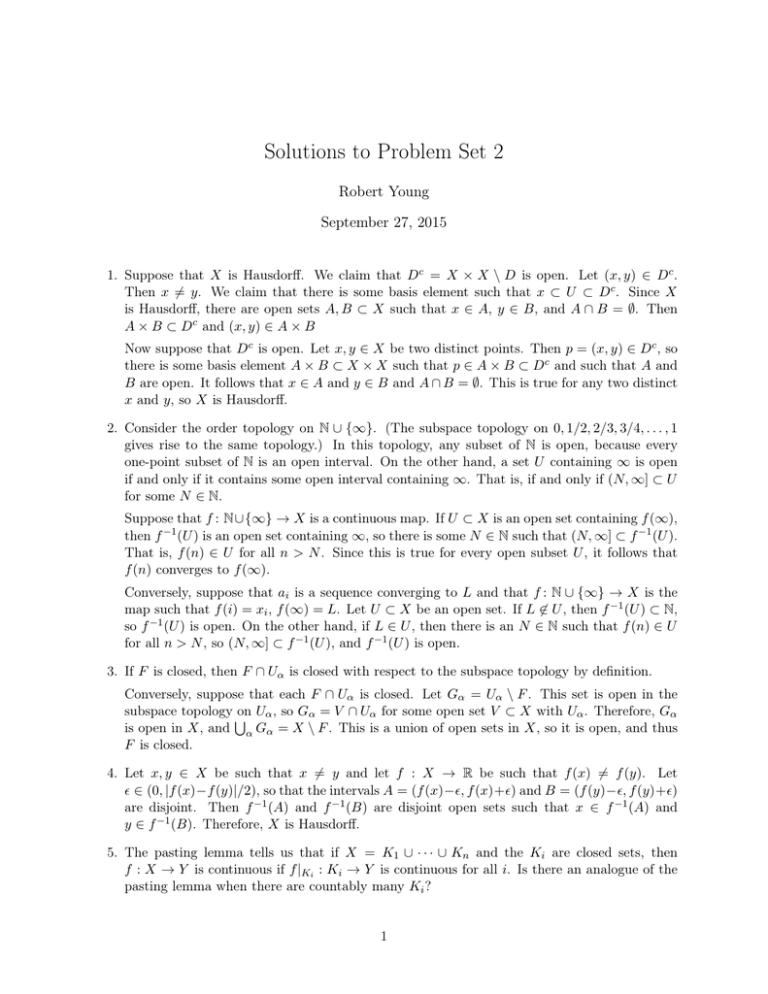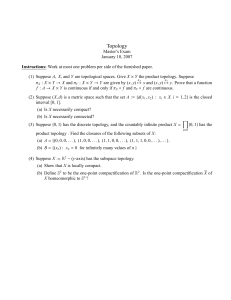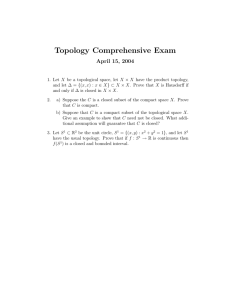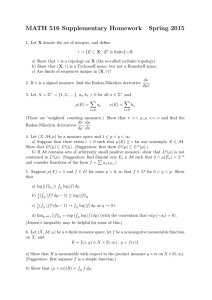Solutions to Problem Set 2 Robert Young September 27, 2015
advertisement

Solutions to Problem Set 2
Robert Young
September 27, 2015
1. Suppose that X is Hausdorff. We claim that Dc = X × X \ D is open. Let (x, y) ∈ Dc .
Then x 6= y. We claim that there is some basis element such that x ⊂ U ⊂ Dc . Since X
is Hausdorff, there are open sets A, B ⊂ X such that x ∈ A, y ∈ B, and A ∩ B = ∅. Then
A × B ⊂ Dc and (x, y) ∈ A × B
Now suppose that Dc is open. Let x, y ∈ X be two distinct points. Then p = (x, y) ∈ Dc , so
there is some basis element A × B ⊂ X × X such that p ∈ A × B ⊂ Dc and such that A and
B are open. It follows that x ∈ A and y ∈ B and A ∩ B = ∅. This is true for any two distinct
x and y, so X is Hausdorff.
2. Consider the order topology on N ∪ {∞}. (The subspace topology on 0, 1/2, 2/3, 3/4, . . . , 1
gives rise to the same topology.) In this topology, any subset of N is open, because every
one-point subset of N is an open interval. On the other hand, a set U containing ∞ is open
if and only if it contains some open interval containing ∞. That is, if and only if (N, ∞] ⊂ U
for some N ∈ N.
Suppose that f : N∪{∞} → X is a continuous map. If U ⊂ X is an open set containing f (∞),
then f −1 (U ) is an open set containing ∞, so there is some N ∈ N such that (N, ∞] ⊂ f −1 (U ).
That is, f (n) ∈ U for all n > N . Since this is true for every open subset U , it follows that
f (n) converges to f (∞).
Conversely, suppose that ai is a sequence converging to L and that f : N ∪ {∞} → X is the
map such that f (i) = xi , f (∞) = L. Let U ⊂ X be an open set. If L 6∈ U , then f −1 (U ) ⊂ N,
so f −1 (U ) is open. On the other hand, if L ∈ U , then there is an N ∈ N such that f (n) ∈ U
for all n > N , so (N, ∞] ⊂ f −1 (U ), and f −1 (U ) is open.
3. If F is closed, then F ∩ Uα is closed with respect to the subspace topology by definition.
Conversely, suppose that each F ∩ Uα is closed. Let Gα = Uα \ F . This set is open in the
subspace topology S
on Uα , so Gα = V ∩ Uα for some open set V ⊂ X with Uα . Therefore, Gα
is open in X, and α Gα = X \ F . This is a union of open sets in X, so it is open, and thus
F is closed.
4. Let x, y ∈ X be such that x 6= y and let f : X → R be such that f (x) 6= f (y). Let
∈ (0, |f (x)−f (y)|/2), so that the intervals A = (f (x)−, f (x)+) and B = (f (y)−, f (y)+)
are disjoint. Then f −1 (A) and f −1 (B) are disjoint open sets such that x ∈ f −1 (A) and
y ∈ f −1 (B). Therefore, X is Hausdorff.
5. The pasting lemma tells us that if X = K1 ∪ · · · ∪ Kn and the Ki are closed sets, then
f : X → Y is continuous if f |Ki : Ki → Y is continuous for all i. Is there an analogue of the
pasting lemma when there are countably many Ki ?
1
No. For example, consider f : R → R,
(
0 if x < 0
f (x) =
.
1 if x ≥ 0
1
1
This is discontinuous, but
S if K0 = [0, ∞), K1 = (−∞, −1], and Ki = [− i−1 , − i ] for i > 1,
then each Ki is closed, Ki = R, and f |Ki is continuous for all i.
6. In problem set 1, we considered a metric topology on the set S2 of 0-1 sequences. Suppose
that for all i, {ain }∞
n=1 is a 0-1 sequence. Show that
∞
lim {ain }∞
n=1 = {bn }n=1
i→∞
if and only if limi→∞ ain = bn for every n.
First, suppose that limi→∞ ain = bn for every n. This implies that for every n, there is a kn
such that for all i > kn we have ain = bn . Consequently, if i > max{kn | n = 1, . . . , N }, then
∞
−1
d({ain }∞
.
n=1 , {bn }n=1 ) < N
It follows that
∞
lim {ain }∞
n=1 = {bn }n=1 .
i→∞
Conversely, suppose that
∞
lim {ain }∞
n=1 = {bn }n=1
i→∞
and let N > 0. There is some K such that if k > K, then
∞
−1
d({akn }∞
.
n=1 , {bn }n=1 ) < N
Therefore, akN = bN for all k > K, and limi→∞ aiN = bN .
2






